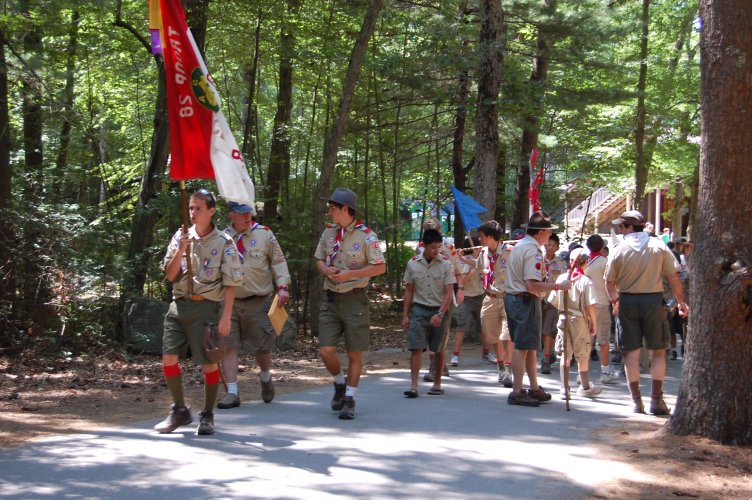

Welcome to Boy Scout Troop 28! The Scouts and the adult leaders of our Troop are excited about your families' participation and getting to know you over the coming years. As you will soon discover, Boy Scouting is much different than being a Cub Scout. You and your son are starting out on a great new adventure. During the years to come, you will have a chance to share wonderful new experiences with your Scout and he will have the opportunity to learn new skills, go places, and do things other young men can only dream about, as well as learn and practice leadership skills within the Troop. We hope all of you will also enjoy building new friendships with those in the Troop.
As a Boy Scout in Troop 28, earning merit badges and rank advancement will depend on your son's organizational skills and his desire to succeed. Although you will be encouraging and helping along the way, he is the one who will decide what his goals are and how he will achieve them. In the Scouting program nationwide, only 4% of all scouts attain the rank of Eagle Scout. No matter what your son's goals are in Scouting and in life, all of us at Troop 28 are here to help in any way we can to achieve those goals. The enclosed information is intended to better acquaint you and your son with Troop 28 and answer some of the questions you may have. Please read through this information and share it with your Scout. Portions of this handbook will be updated periodically for changes in the roster, calendar, and adult leaders, so please keep it as a ready reference during your son's Scouting career. Once again, welcome and we hope the coming years with Troop 28 will be fun-filled and challenging for everyone.
Yours in Scouting,
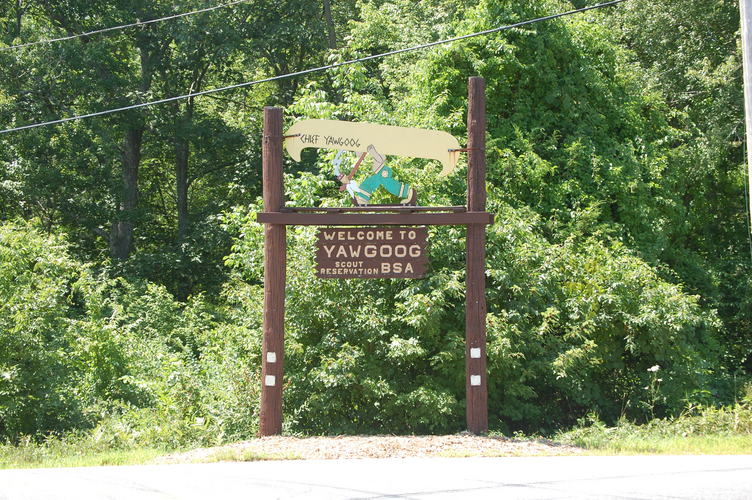
The Committee of Troop 28
Joining a Boy Scout troop can be overwhelming for new Scouts as well as their families because there is so much to learn about the Troop's organization, how it operates, and the opportunities that are available. We encourage you to ask lots of questions, visit the numerous resources that are available on the internet, and seek out additional resources through the Boy Scouts of America National Council, Narragansett Council, or your Scoutmaster. The purpose of this Troop Handbook is to provide you with an introduction to help you get started in Scouting with Troop 28. Hopefully it will also serve as a ready reference you can use to refresh your memory about key elements of our program. While troop policies are discussed to some extent in order to describe how the Troop functions, this handbook is not a policy document and is not intended to supersede any such guidance provided elsewhere such as in the Troop Bylaws or by higher authority such as the Narragansett Council or the National Council, BSA.
The following overview should help set your expectations regarding our program. Later sections will get into more specific information and practical matters.
A superb history of Scouting in the United States written by Jeff Snowden can be found at: www.troop97.net/bsahist1.htm. An excerpt follows:
Scouting began in England in 1907-08, created by General Robert
Baden-Powell. B-P, a 50-year old bachelor at the time, was one of the
few heroes to come out of Britain's Boer War. He was known primarily
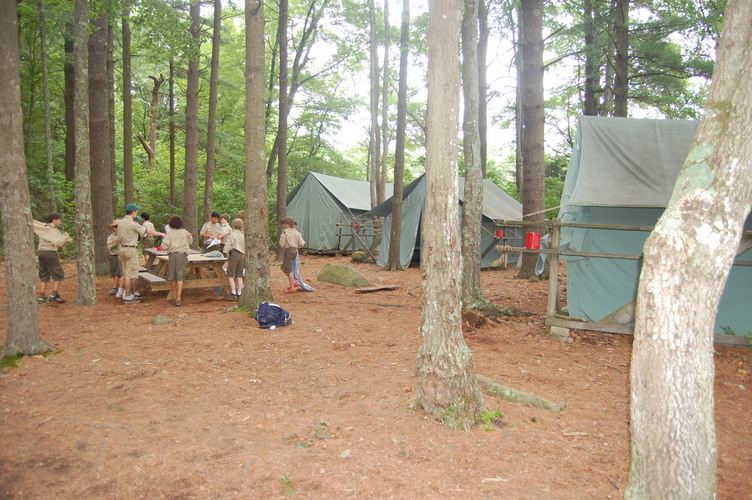 for his unusual ideas about military scouting, explained in his book
Aids to Scouting. Startled to discover that many boys were using his
military book as a guide to outdoor activities, he began to think how
he could convert his concepts of army scouting for men to “peace
scouting” for boys. Gathering ideas from many sources (including
Ernest Thompson Seton, who had founded a boys organization in the US),
he tested his program on a group of boys on Brownsea Island in
1907. The island camp was successful, so B-P rewrote his military
book, calling it Scouting for Boys. The climate was right for a youth
program like Scouting, and it spread quickly around the British
Commonwealth, then to other countries.
for his unusual ideas about military scouting, explained in his book
Aids to Scouting. Startled to discover that many boys were using his
military book as a guide to outdoor activities, he began to think how
he could convert his concepts of army scouting for men to “peace
scouting” for boys. Gathering ideas from many sources (including
Ernest Thompson Seton, who had founded a boys organization in the US),
he tested his program on a group of boys on Brownsea Island in
1907. The island camp was successful, so B-P rewrote his military
book, calling it Scouting for Boys. The climate was right for a youth
program like Scouting, and it spread quickly around the British
Commonwealth, then to other countries.
Today, Scouting is found in 185 of the world's 192 independent countries. The United States has a single national Scouting organization (there are a number of countries, mostly in Europe, that have several separate Scout organizations, divided by religion or language, with different uniforms, advancement, and national hierarchies). Scouting is the world's most successful youth movement.
The purpose of Boy Scouting has been very simply stated as follows:
“The Boy Scouts of America was incorporated to provide a program for community organizations that offers effective character, citizenship, and personal fitness training for youth. Specifically, the BSA endeavors to develop American citizens who are physically, mentally, and emotionally fit; have a high degree of self-reliance as evidenced in such qualities as initiative, courage, and resourcefulness; have personal values based on religious concepts; have the desire and skills to help others; understand the principles of the American social, economic, and governmental systems; are knowledgeable about and take pride in their American heritage and understand our nation's role in the world; have a keen respect for the basic rights of all people; and are prepared to participate in and give leadership to the American society.”
The Boy Scouts of America is the nation's foremost youth program of character development and values-based leadership training. In the future, Scouting will continue to:
The mission of the Boy Scouts of America is to prepare young people to make ethical and moral choices over their lifetimes by instilling in them the values of the Scout Oath and Law.
On my honor I will do my best
To do my duty to God and my country
and to obey the Scout Law;
To help other people at all times;
To keep myself physically strong,
mentally awake, and morally straight.
A Scout is:
Trustworthy
Loyal
Helpful
Friendly
Courteous
Kind
Obedient
Cheerful
Thrifty
Brave
Clean
Reverent
Do a good turn daily.
Additionally, Boy Scouting uses the outdoors as a setting to achieve its aims and methods. Therefore all Scouts are also expected to live up to the Outdoor Code.
As an American, I will do my best to be-
Clean in my outdoor manners,
Careful with fire,
Considerate in the outdoors, and
Conservation minded.
Troop 28 Providence embraces the Aims, Purposes and Methods of the Boy Scouts of America. We are a boy-led Troop supported by a committee of adults dedicated to developing our leaders of tomorrow through our outdoor program.
The aims of the Scouting program are to build character, foster citizenship, and develop fitness. These aims are achieved through a series of Scouting methods that consist of ideals, patrol method, outdoors, advancement, personal growth, adult association, leadership development, and the uniform.
The ideals of Scouting are found in the Scout Oath, Law, Motto, and Slogan. All Scouts are expected to live by these ideals. The patrol method develops leadership and teamwork abilities in a small group setting before it is applied in a larger Troop setting. The outdoors is the key setting where the aims and methods are achieved. Weekend camping establishes self-reliance as the scouts learn to work together and survive on their own.
Advancement creates a challenge to all Scouts by providing them with a series of obstacles to overcome. Furthermore, it provides a rewarding sense of accomplishment for the Scout's hard work and determination. Personal growth is developed as Scouts plan for the Scouting year, provide service, and earn advancement. All these activities provide an opportunity for the Scouts to grow as individuals and members of their community and religious organizations. Adult association provides role models for the Scouts to observe and also creates a setting where adults and boys work together to achieve common goals and have fun while doing so. Leadership development is formed as each Scout assumes a Junior Leader position. The development starts with patrol positions on a small level and fully develops as Scouts assume positions of more responsibility within the Troop that are essential to its operation. Remember that your sons lead the Troop. Finally, the uniform gives the Scouts an identity and sense of belonging to the group.
One way to look at the Troop is to view it as a pyramid. The local Troop is supported by a vast network of local adult volunteers, the Chartering Organization, and Scouting families such as yours, as well as, regionally and nationally by both volunteers and paid professionals. Another way to look at the Troop is in the context of where it is placed within the National Organization. The following sections discuss the Scouting hierarchy and how all the pieces come together.
First and foremost, the boy is the reason the organization exists. This is why he is shown at the top of the pyramid. Programs are specifically designed to meet his needs at the appropriate age and grade level.
 Adult volunteers work at all levels of Scouting. They may be a
Scoutmaster or Troop Committee members, a District Committee member,
or the National President. Working with the volunteers is a group of
dedicated paid professionals who are there to support the volunteers'
work.
Adult volunteers work at all levels of Scouting. They may be a
Scoutmaster or Troop Committee members, a District Committee member,
or the National President. Working with the volunteers is a group of
dedicated paid professionals who are there to support the volunteers'
work.
Organizations are granted a charter by the BSA. The organization may be a church, civic group, school, or other such organization that seeks permission and works in conjunction with the BSA to provide an outreach program for youth. The Chartering Organization is the “franchisee” and as such is the “owner-operator” of the Scouting program. The Chartering Organization typically provides the meeting facilities, storage, and general program support. The Scoutmaster and Committee Chair work directly for the Charter Organization. Our Troop has been serving the youths in our community since 1986. Our Charter Organization is Central Congregational Church, Providence, RI.
The national organization consists of four regions, 33 areas, and the National Office is in Irving, Texas. The National Office develops program, policy training, literature, and videos, and maintains the standards for the organization. There is a national volunteer board that oversees the National Council.
A council is a geographic area composed of districts. Each council has an executive board of volunteers and a paid staff of professionals. The Council supports Chartering Organizations by providing materials, executive direction, training opportunities, and certain facilities, such as camps. There are approximately 300 councils in the BSA. Troop 28 is in Narragansett Council. More information about Narragansett Council may be found at www.narragansettbsa.org
A service area is a geographic area designed to support Scouting in a region through training, program planning, and support. A Service Team is composed of volunteers and paid professionals who deal with specific tasks, including membership, program, and finance. There are “sales” and “service” elements in Service Area support. A Service Area Commissioner along with other volunteers will coach your unit adults, help solve problems, and provide other guidance as needed. Troop 28 is in the Northwest Service Area. More information about Narragansett Council Service Areas may be found at www.narragansettbsa.org/volunteers/districts
The Scouts, under the guidance, direction, and support of adult volunteers, directly lead Troop 28 and are responsible for its success and failures. In the words of the National program, Troop 28 is a boy-led Troop. To this end, the Scouts determine some of the Troop's policies and procedures; plan Troop meetings; select, schedule, and plan outings; and execute their plans, as well as, request any logistic and financial support required for an event to be successful. Because Troop 28 is a boy-led organization, the boys learn the skills to be successful and can practice leadership in a safe environment. This training is one of the Scoutmaster's most important responsibilities. The Scoutmaster provides the direction, coaching, and mentoring that empowers the boys with the skills they will need not only to fulfill a leadership position within the troop, but to successfully take on challenges throughout their lives.
Scoutmasters (and Assistant Scoutmasters) are the most visible of the
 adult volunteers in the organization. Scoutmasters can be viewed in
much the same way as a coach of a sports team. It is their job to
ensure health and safety, maintain discipline, and keep the Troop
positively motivated. A Scoutmaster is primarily a mentor and is
himself or herself a living example of the Scout Oath and Scout Law.
The Scoutmaster's duties include:
adult volunteers in the organization. Scoutmasters can be viewed in
much the same way as a coach of a sports team. It is their job to
ensure health and safety, maintain discipline, and keep the Troop
positively motivated. A Scoutmaster is primarily a mentor and is
himself or herself a living example of the Scout Oath and Scout Law.
The Scoutmaster's duties include:
To fulfill his obligation to the troop, the Scoutmaster, with the assistance of the troop committee, recruits assistant Scoutmasters to help operate the troop. Each assistant Scoutmaster is assigned specific program duties and reports to the Scoutmaster. They also provide the required two-deep leadership standards set by the Boy Scouts of America. An assistant Scoutmaster may be 18 years old, but at least one in each troop should be 21 or older, so he can serve in the Scoutmaster's absence.
A troop should recruit as many assistant Scoutmasters as possible. it has been found that many successful troop have three or more.
The flow of new Scouts is an essential element of a healthy Scout troop. Boys joining a troop bring fresh enthusiasm and energy to the entire program. Many troops assign an assistant Scoutmaster to be responsible for troop membership growth such as the Webelos-to-Scout plan, recruiting new Scouts, and troop rallies for new members.
Membership should be a shared concern of all adult leaders, but someone should have the specific responsibility of steady new boy recruitment. If there is no assistant Scoutmaster handling this important duty, a troop committee member should be responsible.
The Troop Committee, headed by a Committee Chairman, provides the behind the scenes support to the Troop. Tasks such as fundraising, awards, record keeping, equipment purchases, and training are handled by the Committee and designated Committee Coordinators. The Troop Committee is always looking for volunteers to either fill Coordinator positions and/or provide short-term support for a particular event or project. All parents of scouts are considered members of the Committee and are highly encouraged to attend all Committee Meetings. See Appendix A for more information on the Troop Committee and its members.
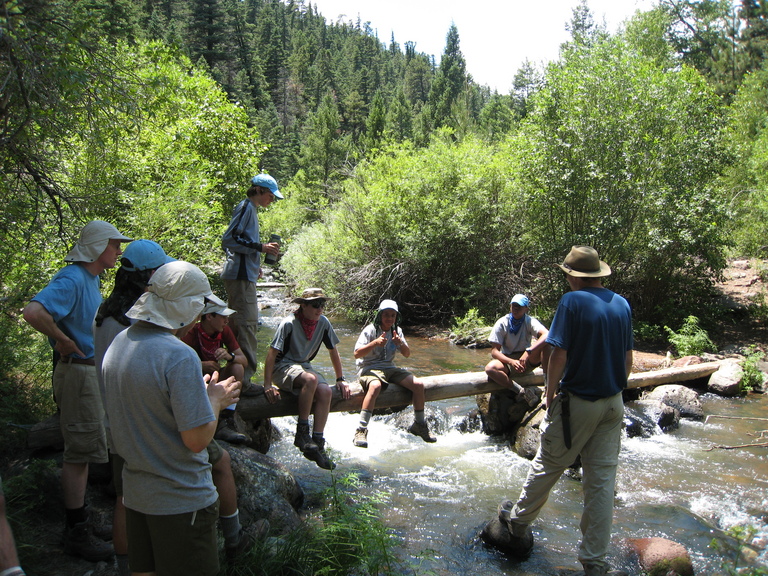 The Troop is divided into patrols, depending on the total number of
Scouts in the troop. When first joining Troop 28, the boys are placed
in patrols that include 6 ~ 8 other boys of similar age. New Scout
Patrols will work closely with an older, experienced Scout called a
Troop Guide who is assigned to help the new patrol get started on the
right foot. The Troop Guide will provide assistance and direction to
the new Scouts and help acclimate them to the Boy Scout program. It is
still up to the members of the new patrol to decide what they want to
do and accomplish as a patrol . Each patrol elects a Patrol Leader
(PL) who serves for a six month term. His job is to plan and guide his
patrol meetings and activities and motivate his patrol members to work
hard and have fun. A good Patrol Leader knows the advancement needs
and outing interests of all his Scouts and works to satisfy those
needs and interests by communicating those needs and interests to the
Patrol Leaders Council (PLC). The PL is responsible for communicating
information to and from his patrol in a timely fashion. During
meetings, campouts, and other events, the Patrol Leader will need the
help and full cooperation of his patrol members to be successful. The
Patrol Leader will also appoint an Assistant Patrol Leader to manage
things when he can't be there. New Scouts soon realize that there are many
things that need to be done. The Patrol Leader serves his patrol, but
also works directly for and with the Senior Patrol Leader.
The Troop is divided into patrols, depending on the total number of
Scouts in the troop. When first joining Troop 28, the boys are placed
in patrols that include 6 ~ 8 other boys of similar age. New Scout
Patrols will work closely with an older, experienced Scout called a
Troop Guide who is assigned to help the new patrol get started on the
right foot. The Troop Guide will provide assistance and direction to
the new Scouts and help acclimate them to the Boy Scout program. It is
still up to the members of the new patrol to decide what they want to
do and accomplish as a patrol . Each patrol elects a Patrol Leader
(PL) who serves for a six month term. His job is to plan and guide his
patrol meetings and activities and motivate his patrol members to work
hard and have fun. A good Patrol Leader knows the advancement needs
and outing interests of all his Scouts and works to satisfy those
needs and interests by communicating those needs and interests to the
Patrol Leaders Council (PLC). The PL is responsible for communicating
information to and from his patrol in a timely fashion. During
meetings, campouts, and other events, the Patrol Leader will need the
help and full cooperation of his patrol members to be successful. The
Patrol Leader will also appoint an Assistant Patrol Leader to manage
things when he can't be there. New Scouts soon realize that there are many
things that need to be done. The Patrol Leader serves his patrol, but
also works directly for and with the Senior Patrol Leader.
In addition to Patrol Leader, there are many other positions that aid in the functioning of the Troop. Troop 28 holds Troop leadership elections every September. These positions include Senior Patrol Leader, Troop Scribe, Troop Quartermaster, Troop Historian, Troop Librarian, Chaplains Aide, and Troop Order of the Arrow Representative. Other positions can be appointed as needed within the Troop.
The following are descriptions of these positions:
Senior Patrol Leader (SPL): The SPL is elected by the scouts as the senior scout leader in the Troop. The SPL runs all troop meetings, events, activities, the annual program planning conference, and Patrol Leaders' Council (PLC) meetings, delegates responsibilities, and interacts with adult leadership. The SPL should be at least a First Class rank scout and must earn the respect and cooperation of his troop to be successful. The SPL reports to the Scoutmaster.
Assistant Senior Patrol Leader (ASPL): The ASPL is the second highest ranking junior leader in the troop and is appointed by the SPL and helps the SPL lead all Troop activities. In the absence of the SPL, the ASPL takes over as the acting SPL. The ASPL reports to the SPL.
Troop Guide: Troop Guide introduces the new scouts to the Troop and how it operates. He trains, guides, and monitors new scouts' progress through their first Scouting year. He supervises and assists the new Scout Patrol Leader in making Patrol decisions. He also helps new Scouts earn First Class within twelve to eighteen months.
Troop Scribe: The Troop Scribe keeps the Troop's records. He attends the Patrol Leaders Council meetings and records the meeting minutes, records attendance and advancement records, and collects permission slips and money, which are turned over to the Scoutmaster and/or Treasurer. The Scribe reports to the SPL.
Troop Quartermaster (QM): The QM maintains records on Troop equipment and ensures the equipment is properly accounted for and maintained. The QM is responsible for organizing the Quartermaster Shack (the Troop's storage facility in the basement of the Church) and the Troop's spaces in the barn and making sure all equipment is properly stowed. The QM is responsible for issuing all equipment needed for outings and weekly meetings and the return of the same after the event. The QM reports to the ASPL.
Troop Historian: The Historian keeps an historical record or scrapbook of Troop activities, cares for the Troop's trophies, ribbons, and souvenirs. The Historian reports to the ASPL.
Troop Librarian: Maintains the troop library, oversees the loaning of Troop literature and makes suggestions for material to be purchased. The Librarian reports to the ASPL.
Chaplain Aide: The Chaplain Aide plans and leads non-denominational services at Troop outings and weekly meetings. He also encourages all Scouts to participate in the religious emblems program. The Chaplain Aide reports to the ASPL.
Troop Order of the Arrow Representative (OA
Rep):
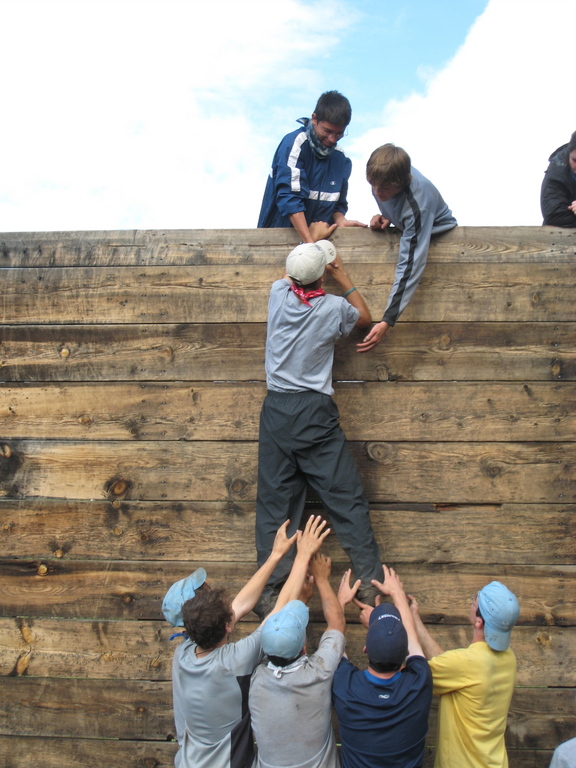 The Order of the Arrow is the National Honor Society of
the Boy Scouts of America. Its purpose is to recognize those campers
who best exemplify the Scout Oath and Law in their daily lives,
develop and maintain camping traditions and spirit, promote year-round
and long-term resident camping, and cheerful service to
others. Members are elected into the organization by their peers.
The Order of the Arrow is the National Honor Society of
the Boy Scouts of America. Its purpose is to recognize those campers
who best exemplify the Scout Oath and Law in their daily lives,
develop and maintain camping traditions and spirit, promote year-round
and long-term resident camping, and cheerful service to
others. Members are elected into the organization by their peers.
As a member of the OA, the OA Representative attends Lodge and/or Service Area meetings and activities and reports to the Troop on what the OA is doing. The OA Rep encourages year round and resident camping in the Troop, encourages older Scout participation in high adventure programs, encourages Scouts to actively participate in community service projects, encourages Arrowmen to assume leadership positions in the Troop, encourages Arrowmen in the Troop to be active participants in the lodge and/or chapter activities and to seal their membership in the Order by becoming Brotherhood members. The OA Rep reports to the OA Chapter Vice Chief.
Den Chief: A Den Chief works with the Cub Scouts, Webelos Scouts and Den Leaders in the local Cub Scout Pack. A Den Chief must know the purposes of Cub Scouting and helps Cub Scouts advance through Cub Scout ranks. A Den Chief encourages Cub Scouts to join a Boy Scout Troop upon graduation and assists with activities in the den meetings. Den Chiefs report to the Den Leader in the Pack.
Troop meetings are conducted by the Troop Leadership, and in particular by the SPL. This is part of the plan to help the Scout grow; to make decisions, and take an active part in making the Troop program successful. But who plans the Troop activities?
The Patrol Leaders Council or PLC is charged with the responsibility of deciding what the Troop will do by planning and carrying out meetings and activities. Every Scout, through his Patrol Leader, has a voice in the planning and running of the Troop's activities. This does not mean that every Scout will be able to do what he wants when he wants. Rather, this process helps Scouts learn citizenship and cooperation. The PLC is composed of the Senior Patrol Leader, Assistant Senior Patrol Leader, Patrol Leaders, and the Senior Patrol Leader's Staff (including Troop Guides). Troop 28's PLC typically has two major planning meetings a year. The first PLC is held in August with the primary focus being on planning the majority of the Troop's campouts and events for the coming year. The second major meeting is in January where the Troop's annual calender is reviewed and updated as required. All of the PLCs are held monthly at the home of one of the Scouts or adult leaders, or in a conference room at the Church.
Taking on a leadership position in the Troop is an important part of the Scouting experience and is necessary for continued advancement. When chosen to serve in a leadership position, a Scout must agree to fulfill the requirements of the job to the best of his abilities. The Troop can vote to remove a Scout from serving in a leadership position if a Scout fails to perform his duties. After each election is held, Junior Leadership Training (JLT) is offered and led by the Scoutmaster and the senior boy leaders in the Troop. At the training weekend, leadership skills and styles are explored and discussed.
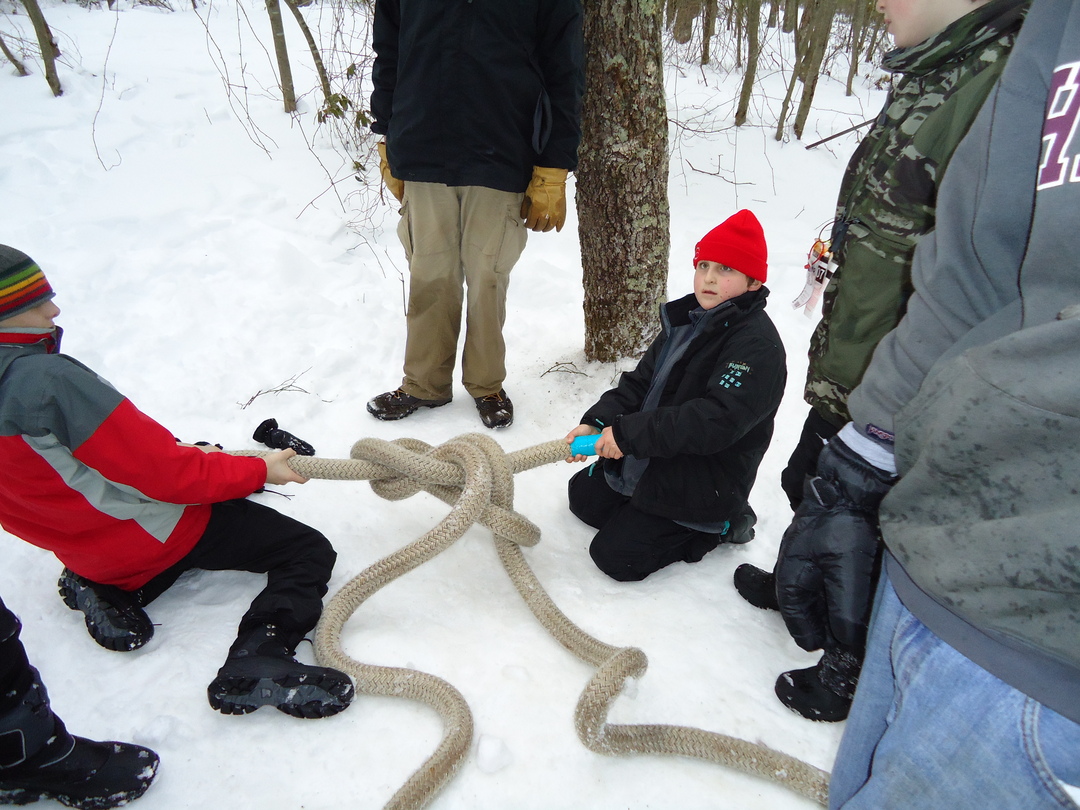 The heart of the Scout program is the Troop meeting, where all Scouts
come together each week for an evening of fun, instruction,
advancement work, and trip preparation. Troop 28 meets at
Central Congregational Church each Tuesday evening from 7:00 p.m. to 8:30 p.m.
We have been meeting here for more than 30 years and are grateful
to the church for the meeting space it provides. The boys will be
notified if it is necessary to cancel a meeting for any reason.
Attendance at Troop meetings is very important. If a Scout attends
only the campouts and not the weekly Troop meetings, he may find
himself ill prepared without the needed skills or participation in the
planning. Similarly, if a boy attends only the Troop meetings and not
the field events, he may find the meetings boring because he doesn't
see the final event that the Troop meetings are leading up to. He will
also miss the opportunity to put into practice the skills that he is
learning at the meetings. Normally, a Scout will not be considered an
active member unless he attends the prescribed number of meetings and
planned activities. Scouts should wear their proper uniform to all
troop meetings and bring their Boy Scout Handbook, unless otherwise
instructed.
The heart of the Scout program is the Troop meeting, where all Scouts
come together each week for an evening of fun, instruction,
advancement work, and trip preparation. Troop 28 meets at
Central Congregational Church each Tuesday evening from 7:00 p.m. to 8:30 p.m.
We have been meeting here for more than 30 years and are grateful
to the church for the meeting space it provides. The boys will be
notified if it is necessary to cancel a meeting for any reason.
Attendance at Troop meetings is very important. If a Scout attends
only the campouts and not the weekly Troop meetings, he may find
himself ill prepared without the needed skills or participation in the
planning. Similarly, if a boy attends only the Troop meetings and not
the field events, he may find the meetings boring because he doesn't
see the final event that the Troop meetings are leading up to. He will
also miss the opportunity to put into practice the skills that he is
learning at the meetings. Normally, a Scout will not be considered an
active member unless he attends the prescribed number of meetings and
planned activities. Scouts should wear their proper uniform to all
troop meetings and bring their Boy Scout Handbook, unless otherwise
instructed.
The wearing of the Boy Scout uniform is an important part of Scouting in Troop 28. It encourages a sense of identity, fosters a feeling of belonging, and promotes the idea of equality in the brotherhood of Scouting. The Troop maintains a uniform 'closet' and we encourage boys who have outgrown their uniforms or who are leaving Scouting to donate their uniforms to the Troop uniform exchange program.
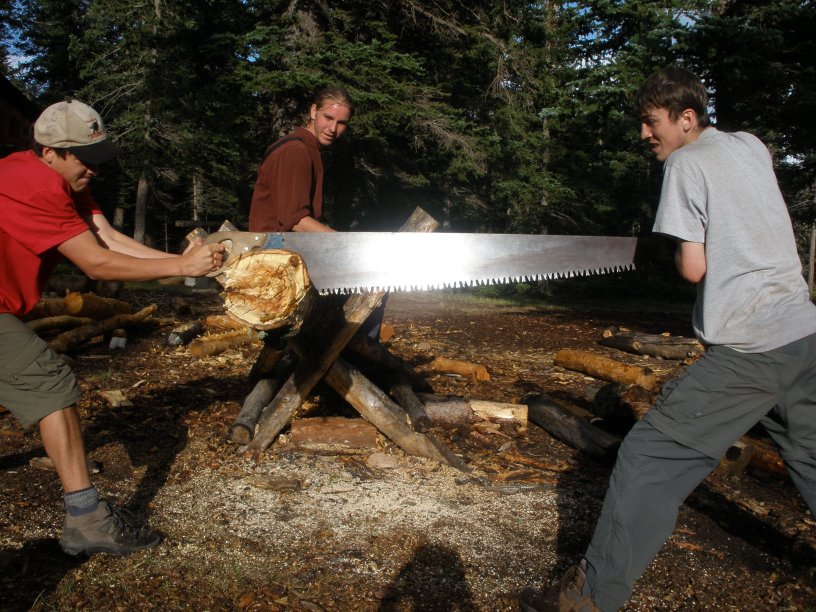 Scouts in Troop 28 wear different levels of uniform for
different events. It will be announced before an event or an outing
whether the Scouts need to wear their Class A, B or C uniform. Generally the Class
A uniform (the complete uniform) is worn for all special events such
as dinners, recognition events, Boards of Review and Eagle Court of Honor.
The Class A uniform is also worn at weekly Troop meetings.
Scouts in Troop 28 wear different levels of uniform for
different events. It will be announced before an event or an outing
whether the Scouts need to wear their Class A, B or C uniform. Generally the Class
A uniform (the complete uniform) is worn for all special events such
as dinners, recognition events, Boards of Review and Eagle Court of Honor.
The Class A uniform is also worn at weekly Troop meetings.
No sweaters, sweatshirts, long-sleeved undershirts, etc may be worn over or be visible as part of the Class A uniform. All insignias and badges should be properly placed on attire in accordance with BSA standards. Excerpts from the official BSA insignia guide are provided in the Boy Scout Handbook. Please refer to this guidance to ensure proper placement of badges and awards.
The Class B uniform is the same as Class A, except no medals, neckerchief or sashes are worn. It is OK for sweaters and sweatshirts and for other types of shoes (sneakers OK). Class B is our normal uniform for meetings, and other times as directed by the Scoutmaster or SPL.
Troop 28 T-shirt, any shorts (preferably BSA), any socks (preferably BSA) and any shoes. Class C is our informal summer uniform for camp and meetings except when Class A or B is required.
Open toe shoes or sandals may be worn for certain activities only at the discretion of the Scoutmaster or adult leader in charge of the event provided they will not pose a safety risk to the Scout. Because of the nature of many of our outdoor activities, sandals will not normally be considered appropriate footwear.
We believe that a Scout should receive recognition for his achievements. Formal recognition and positive reinforcement through rank advancement helps establish a life-long pattern of setting and reaching goals. Although the advancement process may seem daunting and the requirements rigorous, it has been established to build confidence in the Scout and to be a positive and meaningful growth experience. There is also a lot of fun and excitement along the way and no Scout goes through the process without help and guidance. Even though it's not one of the primary aims of Scouting, advancement is a natural byproduct of the Scouting experience.
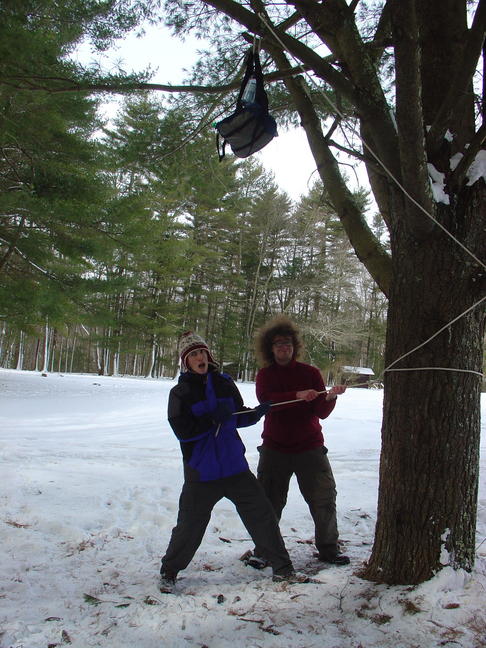 A Scout can work on advancement requirements with his parents or other
family members, other Scouts, and Scout leaders. This can be done
individually, during Patrol and Troop meetings, and other Troop
functions such as campouts. As each requirement is completed, a Scout
will be tested and the requirement 'signed off' in the
Scout's Scout Handbook. The Scoutmaster and Assistant Scoutmaster
are the only individuals authorized to initial or 'sign off' the
requirements for the ranks up to First Class, with the exception of
those specifically assigned by the Scoutmaster. Ranks must be earned
in order, but any requirement for Tenderfoot through First Class may
be completed at any time. For example, you may complete a First Class
requirement before finishing your Tenderfoot requirements, but you
must earn the Tenderfoot rank before you are awarded Second Class and
First Class ranks.
A Scout can work on advancement requirements with his parents or other
family members, other Scouts, and Scout leaders. This can be done
individually, during Patrol and Troop meetings, and other Troop
functions such as campouts. As each requirement is completed, a Scout
will be tested and the requirement 'signed off' in the
Scout's Scout Handbook. The Scoutmaster and Assistant Scoutmaster
are the only individuals authorized to initial or 'sign off' the
requirements for the ranks up to First Class, with the exception of
those specifically assigned by the Scoutmaster. Ranks must be earned
in order, but any requirement for Tenderfoot through First Class may
be completed at any time. For example, you may complete a First Class
requirement before finishing your Tenderfoot requirements, but you
must earn the Tenderfoot rank before you are awarded Second Class and
First Class ranks.
Specific knowledge, skills, and experience required for advancement to each rank are explained in detail in the Boy Scout Handbook. The requirements for the ranks of Tenderfoot through First Class are designed to prepare young Scouts to take full advantage of all that Scouting has to offer by focusing first on the mastery of certain skills and basic knowledge. Gradually the focus shifts to more advanced skills until at the level of Star, Life, and Eagle, the Scout becomes responsible for leadership of the troop and learning the important lessons of citizenship and service to others.
Scouting skills cannot be mastered by performing them just once and knowledge will fade if not occasionally refreshed. A Scout is therefore encouraged to practice his skills often and study what he has learned in order to make it part of his everyday life. Scouts will have many opportunities to practice their skills and to be thoroughly tested on each requirement before it is signed off. Additionally, as a Scout grows and makes progress through the ranks, he will also be expected to teach what he knows to less experienced Scouts, which will further reinforce his own knowledge and skills. These are the reasons why it is imperative that scouts attend as many Troop meetings and activities as possible.
It's up to individual Scouts to take advantage of the advancement opportunities available and to take the initiative by asking someone to test them when they are ready. Each Scout is also responsible for keeping his own personal advancement records and documenting his service hours, campouts, troop activities, and leadership positions in his Boy Scout Handbook. Each Scout will meet regularly with the Scoutmaster to discuss his activity in the Troop and understanding and practice of the ideals of Scouting. This Scoutmaster Conference is used to discuss goals and accomplishments and is required for each rank advancement. However, a Scout doesn't have to wait until completing all the requirements for a given rank in order to ask for a Scoutmaster Conference. He may talk with the Scoutmaster at any time that is mutually convenient. For a Scoutmaster Conference to count toward rank advancement though, it must take place after all other requirements are complete and before the Board of Review. At this required conference, the Scoutmaster will determine whether or not the Scout is ready to go before the Board of Review.
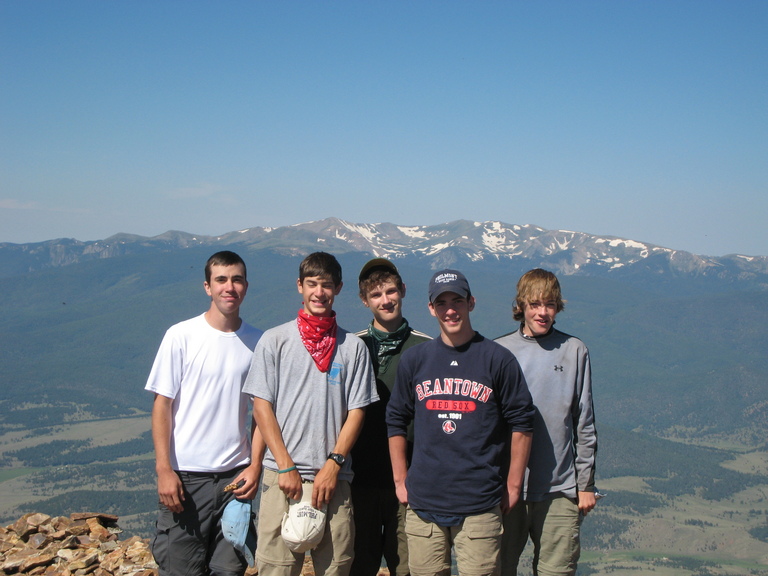 If
at the this Scoutmaster Conference it is determined that a Scout is
ready to advance, the Scout should request a Board of Review following
established procedures. Boards of Review, for all ranks except Eagle
Scout, are normally held within a week or two of the request, and are
composed of three to six registered members of the Troop
Committee. Eagle Scout Boards of Review are comprised of individuals
outside the Troop and therefore take longer to arrange. The Board of
Review may not include the Scoutmaster, Assistant Scoutmasters, or
family members of the Scout being boarded. The purpose of the Board of
Review is to ensure that all of the requirements have been completed,
to monitor the quality of the Troop experience for each Scout, and to
encourage the Scout to advance toward the next rank.
If
at the this Scoutmaster Conference it is determined that a Scout is
ready to advance, the Scout should request a Board of Review following
established procedures. Boards of Review, for all ranks except Eagle
Scout, are normally held within a week or two of the request, and are
composed of three to six registered members of the Troop
Committee. Eagle Scout Boards of Review are comprised of individuals
outside the Troop and therefore take longer to arrange. The Board of
Review may not include the Scoutmaster, Assistant Scoutmasters, or
family members of the Scout being boarded. The purpose of the Board of
Review is to ensure that all of the requirements have been completed,
to monitor the quality of the Troop experience for each Scout, and to
encourage the Scout to advance toward the next rank.
The Scout must have his Boy Scout Handbook when appearing before the Board. During the review, the board will ask leading questions about the Scout's development along the trail to Eagle, ask questions about required skills, and evaluate the Scouting terms of Troop activities and readiness for the next rank. It is also a time for the Scout to ask questions and provide feedback to the Troop Committee about what is being done well in the Troop and what could be done better. At the end of the review the Scout will be asked to leave the room while the board discusses his qualifications and decides whether or not he is ready to advance to the next rank. The board then calls the Scout back into the room and informs him of its decision.
After passing the Board of Review, the Scout will be recognized in front of the troop as soon as possible. He will receive the new rank patch at that time. The Scout may also be formally recognized later for his rank advancements and merit badges in front of family and friends during a Court of Honor ceremony. If such a ceremony is held, the Scout will be presented with his wallet-sized certificate card and a rank pin (“mother's pin”). Parents, other family members, and friends are always invited and encouraged to attend Courts of Honor.
After reaching the rank of Life Scout, a Scout will meet with one of the adult leaders in the Troop, receive his Life to Eagle packet, and discuss ideas and suggestions about his Eagle Service Project. This project must conform to special guidelines that have been outlined by the Boy Scouts of America. The Scoutmaster, the Troop Advancement Chairman, and a representative of the District Advancement Committee, as well as the benefiting organization, must approve the project before a Scout can begin carrying it out and all requirements for the rank of Eagle must be completed before the Scout's 18th birthday. There are no exceptions to the age limit.
While certain merit badges are required for rank advancement, other merit badges allow a Scout to explore many interesting fields of study, help round out his skills, and introduce him to subjects that will perhaps become lifelong interests or even lead to a career. There are more than 100 merit badges to choose from and merit badges may be earned at any time with Scoutmaster approval. A Scout doesn't need to reach a certain rank in order to be eligible.However, he should concentrate on achieving the rank of First Class before devoting significant time to working on merit badges. Also, a Scout should be careful not to overwhelm himself by trying to complete too many badges at one time or by trying to complete a merit badge which builds on other skills that have not yet been fully mastered. This can lead to unnecessary frustration and disappointment. It is recommended that a Scout actively work on no more than two merit badges at one time before reaching the rank of First Class, and no more than five at one time thereafter.
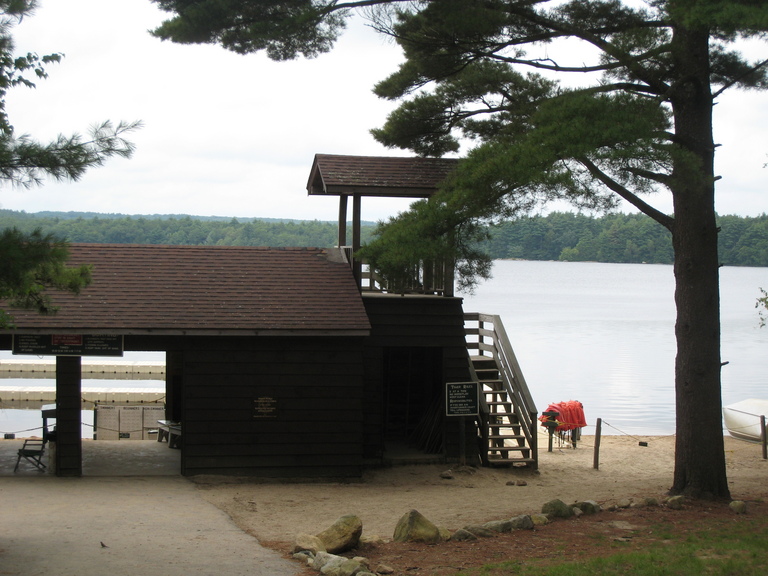 Information about merit badge requirements
can be found in the appropriate merit badge pamphlets and in the
current year's Boy Scout Requirements book. Many of these should be
available in the troop library or at the public library. All of them
are available from the Scout Shop, Council Trading Posts, or other
stores which sell Scouting supplies. Additional information can be
found
at www.meritbadge.com.
Information about merit badge requirements
can be found in the appropriate merit badge pamphlets and in the
current year's Boy Scout Requirements book. Many of these should be
available in the troop library or at the public library. All of them
are available from the Scout Shop, Council Trading Posts, or other
stores which sell Scouting supplies. Additional information can be
found
at www.meritbadge.com.
Here are the steps to earning a merit badge. The Scout should:
 After completing the merit badge, the counselor signs the merit
badge card, and returns the card to the Scout. The Scout then brings
the card to the Advancement Chairman, who will keep the Troop section
and return the Scout section to the Scout. The Scout will receive his
merit badge shortly after turning in the blue card (usually the next
troop meeting).
After completing the merit badge, the counselor signs the merit
badge card, and returns the card to the Scout. The Scout then brings
the card to the Advancement Chairman, who will keep the Troop section
and return the Scout section to the Scout. The Scout will receive his
merit badge shortly after turning in the blue card (usually the next
troop meeting).Advancement records are kept by the Council office, the Troop Advancement Chairman, and by the individual Scout. The Council office keeps records supplied to it by the Troop Advancement Chairman, who also keeps copies of these records for the Troop. The Troop Advancement Chairman also maintains his or her advancement information electronically. The Scout will receive three kinds of documents that must to be KEPT IN A SAFE PLACE UNTIL THE SCOUT REACHES THE AGE OF 18 OR RECEIVES THE EAGLE SCOUT AWARD!
These documents are:
It is vitally important that the above documents are signed or initialed by the appropriate Scout leader. All of the cards and certificates are the same size and can be safely kept in plastic protector pages which are designed for baseball and other sports cards. IT IS VERY IMPORTANT THAT THESE DOCUMENTS BE KEPT IN A SAFE PLACE AND DO NOT GET LOST!!! If it should happen that there is a discrepancy or missing record, the Scout's personal records are the best way to prove that a requirement has been completed.
Safety is our number one concern in Troop 28. The Troop has an excellent safety record that we will strive to maintain as you continue your participation in Scouting. It is imperative that all Scouts and participating adults have on file with the Scoutmaster a current (updated annually) BSA medical form and permission slip. Scouts will not be allowed to participate in any campouts or trips without these two forms on file. The forms can be obtained from the Scoutmaster.
Troop 28 follows the BSA Guide to Safe Scouting to ensure that appropriate safety procedures are followed at all Troop activities. The following highlights some of our rules of safety:
 Tour permits must be obtained from the BSA Council for all camping trips and
outside activities.
Tour permits must be obtained from the BSA Council for all camping trips and
outside activities.Discipline is essential in providing a safe and fun environment for our Scouts to grow. We consider Troop 28 to be a safe haven where young men can learn new skills, have fun, and challenge themselves without fear of physical, verbal, or emotional attacks. Each Scout has agreed to live by the Scout Law, Scout Oath, and Outdoor Code. Violations of the standards and ideals set forth in these precepts will be subject to disciplinary action by the Troop. Disciplinary action will be handled with the utmost seriousness and carried out by the adult leadership of the Troop. In situations requiring immediate attention to protect the health and safety of others and/or prevent property damage, any adult or leader can step in and take appropriate action.
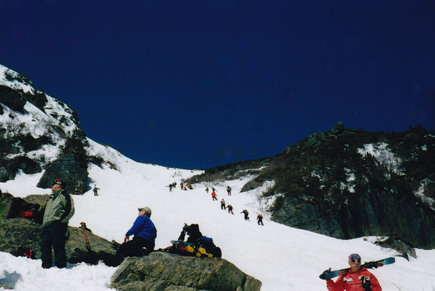 Under no circumstances shall fighting, vulgar language, hazing,
insubordination, pornographic material, theft, destruction of
property, or the use of fireworks, alcohol, illegal drugs, or tobacco,
be tolerated. The Scoutmaster, or other adult leader, may confiscate
any items that are inappropriate or unsafe. Disciplinary actions can
take any number of forms, including, but not limited to: loss of
privileges, parent conferences, extra duties, loss of leadership
position, suspension from troop activities, or resetting of the rank
advancement time requirements, due to the fact the scout has not acted
in accordance with the Scout Oath. Repeated or severe disciplinary
problems may result in expulsion from the Troop.
Under no circumstances shall fighting, vulgar language, hazing,
insubordination, pornographic material, theft, destruction of
property, or the use of fireworks, alcohol, illegal drugs, or tobacco,
be tolerated. The Scoutmaster, or other adult leader, may confiscate
any items that are inappropriate or unsafe. Disciplinary actions can
take any number of forms, including, but not limited to: loss of
privileges, parent conferences, extra duties, loss of leadership
position, suspension from troop activities, or resetting of the rank
advancement time requirements, due to the fact the scout has not acted
in accordance with the Scout Oath. Repeated or severe disciplinary
problems may result in expulsion from the Troop.
Training is an extremely important aspect of the Scouting Program. Our leaders are expected to be fully trained and to conduct Scouting business according to BSA policies. At a minimum all registered leaders in the Troop must be trained in Youth Protection. Basic and advanced level training opportunities for Scouts focus on both Scouting Skills and Leadership Development and take the form of specialized instruction, exciting outings and outdoor activities, and high adventure programs that are only available to Scouts. Additional information on training can be found in WWW.Narragansettbsa.org.
The cost of participating in Troop 28 is broken down in a few different ways. Dues are collected and fundraisers are held throughout the year. Fundraisers such as the annual pancake breakfast raise money for the Troop general fund. All fundraising is coordinated and approved by the Committee.
As illustrated by the Scout Oath and Law, the ideals of Boy Scouting recognize a duty to God, yet how specifically to practice that duty is not prescribed. While faith is a highly personal matter, it is expected that all Scouts will be reverent and respectful not only with respect to their own beliefs, but also to the beliefs of others. Troop 28 encourages all Scouts to worship according to their own beliefs and accepts all Scouts regardless of their religious faith or traditions. While Troop 28 is chartered by Central Congregational Church, membership or participation in activities of that Church is not required. However, the Troop may end a meeting or begin a meal with a brief prayer and may occasionally attend services at Central Congregational for special occasions such as Scout Sunday. We may also attend a Jamboree, Camporee or summer camp where religious services are offered. In these cases, no Scout will be required to participate in any particular prayer or service if he is uncomfortable or if it conflicts with his own beliefs.
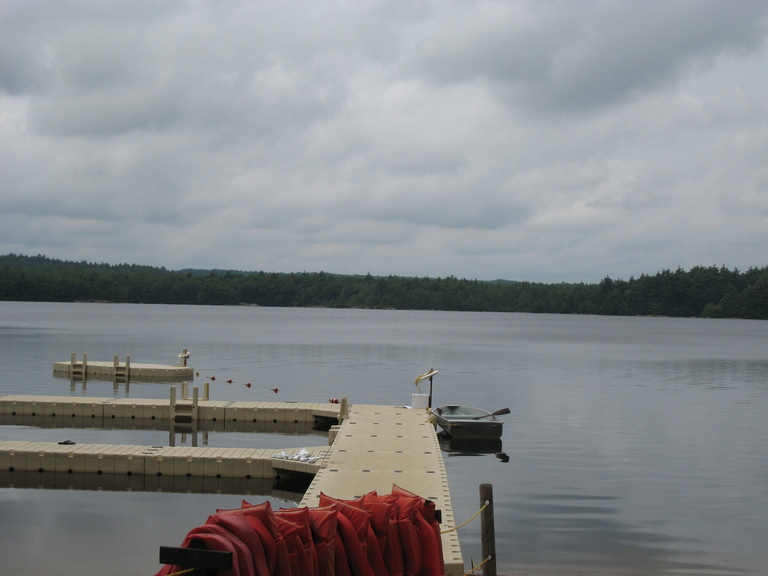 In applying for the Rank of Eagle, a Scout is normally expected to
have a reference letter from a religious leader attesting to how the
Scout has demonstrated a Duty to God. There will also be
opportunities to earn special religious awards. All Scouts are
encouraged to earn the religious award medal of their faith.
In applying for the Rank of Eagle, a Scout is normally expected to
have a reference letter from a religious leader attesting to how the
Scout has demonstrated a Duty to God. There will also be
opportunities to earn special religious awards. All Scouts are
encouraged to earn the religious award medal of their faith.
Camping equipment and gear are an expensive, but necessary investment. It is important to buy quality gear, but it is not necessary to buy it when the scout joins the troop, or to buy it all at once. There are many features and options available in camping gear. Some are functionally important and others are a matter of personal preference. Equipment/gear requirements at this time are minimal in that the Troop has tents, stoves, cook gear, etc. It is recommended that you use Troop gear until you become more familiar with camping gear and gain experience camping. However, typically each boy will own his own sleeping bag, backpack, personal mess kit, and canteen,. See Appendix B for a list of recommended camping gear.
Items For Scouts and Parents:
Communication. Telephone, handouts, and especially email is used extensively to communicate
within the Troop. If you change your email address or phone number, please let the Scoutmaster
or the Troop's Email Coordinator know as soon as possible.
Participation. Satisfactory participation is an important part of being a member of Troop 28, and is required for advancement. Satisfactory participation is defined in the Troop's By-Laws.
Items For Parents:
Drop-off/pick-up. Parents are requested to come into the
meeting room when arriving and when picking up their Scout(s). We need to
know how they are getting to meetings, and with whom they are
leaving. If your scout has his driver's license, another scout
cannot ride to/from any scout activities with him. This is
council policy, and we do not make any exceptions to this rule.
Parental Involvement:
Parents are encouraged to participate with the troop in any capacity.
Options for adult participation include:
| My Patrol Name: | |||
| My Patrol Yell: | |||
| My Patrol Flag: | |||
| My Patrol Leader: | Phone: | ||
| My Assistant Patrol Leader: | Phone: | ||
| Patrol Member: | Phone: | ||
| Patrol Member: | Phone: | ||
| Patrol Member: | Phone: | ||
| Patrol Member: | Phone: | ||
| Patrol Member: | Phone: | ||
| Patrol Member: | Phone: | ||
| Patrol Member: | Phone: | ||
What does the Troop Committee Do?
Typical Committee Positions and Duties
Title/Description
Estimated Average Time Required: 8-12 hours/month
Estimated Average Time Required: 4-6 hours/month
Estimated Average Time Required: 6-10 hours/month
Estimated Average Time Required: 4-6 hours/month
Estimated Average Time Required: 2-4 hours/month
Estimated Average Time Required: 2-4 hours/month
Estimated Average Time Required: 1-2 hours/month
Estimated Average Time Required: 4-6 hours/month
Basic Equipment:
Clothing:
Toilet kit:
Camping Kit:
Separate Gear Items:
†Special/optional equipment for special planned event(s).